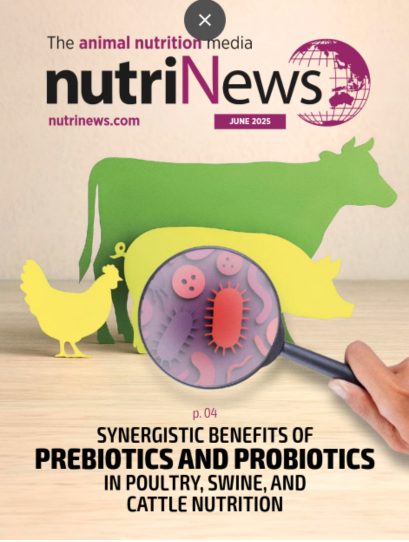Soybean meal (SBM) is the most used source of protein in animal feeding. In this first article of a series of three, the authors review composition and nutrtional value for different species, as well as factors determining their variability.
Introduction
Soybean meal (SBM) is the main source of protein and amino acids (AA) used in animal feed formulations worldwide, particularly for monogastric species. Soybean is a source of high-quality vegetable protein, with a less variable chemical composition than other protein sources. However, due to its high inclusion rates (especially in poultry diets), any lack of uniformity in SBM will have more relevance than a variation in any of the other protein sources added to the formula.
In numerous practical situations, the quality control of soybean meal and derivatives is limited to analyses of moisture, crude fibre, crude protein (CP), and urease activity.
- Analysing only moisture, crude fibre, crude protein (CP), and urease activity is not enough to accurately determine soybean nutritional value.
- Other parameters such as sugar content, NDF, AA profile and variables like trypsin inhibitors (TI), Maillard reactions and KOH protein solubility are rarely examined.
All these parameters are relevant. They allow us to properly evaluate the nutritional value of the ingredient. However, these variables are subjected to variations depending on:
- seed genotype
- type of soil and environmental conditions during growth (Westgate et al., 2000)
- processing characteristics (Grieshop et al., 2003)
- duration of storage (Serrano et al., 2013)
- presence of antinutritional factors (Karr-Lilienthal et al., 2004; Frikha et al. 2012)
- country of origin of the beans (Ravindran et al., 2014; García Rebollar et al., 2014 y 2016).
SBM accounts for the main cost of raw materials in a feed mill.
There is a need to improve the methods currently used for soybean quality control. Most soybean quality control programs focus on the determination of protein content, but not much on the energy value, which reduces their practical relevance.
The objective of present study consists of three parts:
- Identify the main factors affecting the profile and nutritional quality of SBM.
- Define and evaluate the different methodologies used to estimate SBM value and determine possible improvements in quality control in the feed industry.
- Describe the different types of soybean according to its origin.
Nutritional value
What are the existing products on the market?
Different products derived from raw soybeans are available on the market, depending on the type and level of processing (Figure 1).

Figure 1. Products derived from the soja bean.
Solvent processing
- The whole beans containing 36% CP (Figure 2) are dehulled to reduce processing costs and the number of residues.
- Once prepared, the beans are subjected to heating in order to reduce the contents of antinutritional factors (ANF).
- Subsequently the oil is extracted using a solvent. SBM is obtained (48% CP).
- Often, part of the hulls separated in the beginning of the process are added again, producing SBM 44%.
- It should be noted that, in this case, the hulls, which contain certain amounts of trypsin inhibitors (TI), have not been processed.
Heat processing
In certain countries, such as Argentina, solvent extraction is not used to remove oil. Instead, a pressure processing in combination with high temperatures is carried out. In this case, the product obtained is the expeller soybean meal with 40-44% CP and 8-11% fat.
This pressure processing is normally performed in small plants, not always with good facilities. Hence, the products are less uniform, and a strict quality control program is needed.
From the processed and degreased soybeans, value-added products can be generated through:
- Elimination of antigenic factors
- Deactivation of TI and reduction of oligosaccharides
- through fermentation or enzymatic processing (fermented soybean meal: <55% CP)
- or through alcohol extraction (soybean protein concentrate: >65% CP).
Proximate composition and nutritional value of SBM
The chemical composition of SBM is less variable than that of other protein ingredients commonly used in commercial feeds for monogastric animals. However, given its high inclusion level in animal feeds, a high degree of uniformity is required.
- It is common to find considerable differences regarding the content of certain nutrients such as CP, AA and NDF in commercial feeds.Table 1 shows the proximate analysis for soybean meal (47% CP) according to various sources.
Table 1. Proximate composition of soybean meal (47% CP) according to various sources

- CP contents of SBM normally vary depending on the type of bean and the inclusion or not of hulls after the oil extraction process.
- Expected CP levels range from 43 to 45% for standard SBM, and from 46.7 to 48.5% for high protein SBM.
- The AA content of SBM is variable, ranging from 2.7 to 3.0% in the case of total Lys (FEDNA, 2010).
To be considered…
An issue for consideration in practical situations is that most feed mills estimate that the AA proportion (or profile) in SBM is constant. Thus, when the protein level in the matrix is modified, the content of all AA is often modified proportionally. This leads to errors with high impact on production costs.
The availability of AA in soybean is negatively correlated with the presence of ANF, particularly TI and Maillard reactions.
Various studies have demonstrated that the content of essential AA is not proportional to the CP level, and the AA content in soybeans depends not only on its protein content but also on the country of origin of the beans. The SBM received in Europe are often from USA, Brazil/Paraguay or Argentina. In general, soybeans from Brazil/Paraguay contain higher CP levels than those from USA, and these contain higher levels than those from Argentina, provided that hulls are not added to the final product (Table 2).
Table 2. Proximate composition1 (% DM) of soybean meal according to the country of origin of the beans (García Rebollar et al., 2016).

The advantage in CP found in the SBM from Brazil/Paraguay is partly lost when the AA profile is examined, since these meals contain lower levels of Lys, Met, Thr and other essential AA per protein unit compared to SBM from Argentina and USA. Therefore, the advantage of a higher protein level is partly lost since the animals do not need protein, but digestible AA.
In the laboratory, CP is calculated by multiplying the N content of SBM by a conversion factor set at 6.25.
![]() The inclusion of low levels of urea allows for raising the theoretical protein values quite impressively. It should be considered that urea is not toxic for monogastric animals, but its nutritional value for these species is zero.
The inclusion of low levels of urea allows for raising the theoretical protein values quite impressively. It should be considered that urea is not toxic for monogastric animals, but its nutritional value for these species is zero.
Energy value of soybean meals
The calculation of SBM energy value is important for the correct estimation of its nutritional value. However, there is no available methodology defined for estimating its value in different soybean products.
In practice, the metabolizable energy (AMEn; poultry) is determined using prediction equations which are based on the possible energy contribution of its immediate principles. The main disadvantage of this method is that it considers neither the possible variation in protein digestibility, nor the sugar content (often higher than 8-9%) (García Rebollar et al., 2016) or the presence of ANF. All these parameters are variable according not only to soybean processing but also to the origin of the beans.
Other values – Moisture, NDF and EE
SBM contains approximately 12% moisture, 7-13% NDF and 1.7% ethereal extract, while ash represents approximately 6%. These values depend fundamentally on the chemical composition of the original bean, its genetics, but also, and perhaps at a higher proportion, on the geographical region where the soybean was produced. The latitude, which is related to the daylight hours during seed growth and maturation, is a probably key factor to understand bean composition.
- SBM from Brazil and Paraguay, close to Equator, contain more oil and protein, but less sugars (sucrose and oligosaccharides) compared to SBM from Argentina and USA.
- SBM from Brazil and India contain higher NDF for a standard CP level.
- The levels of phosphorus and iron vary according to soil acidity and characteristics, as well as fertilization and growth conditions of the bean (FEDNA, 2010). Iron values are higher for SBM from Brazil, while phosphorus values are slightly higher for SBM from USA.
Conclusion
- Despite its price, soybean meal is a major source of protein for monogastric animals.
- Due to its high inclusion levels, it is necessary to control the various nutritional parameters, particularly those related to the AA profile, AA digestibility, and sugar and energy contents.
- The processing plant, the type of soil, and the place of origin of the soybean (latitude) are parameters affecting its nutritional value.
Further reading
Use of soybean products in animal feeding. Part II – Quality control
Use of soybean products in animal feeding. Part III- Origin
This artcle was originally published in nutriNews Spain, under the title “Uso de productos derivados de soja en alimentación animal . Parte I”














